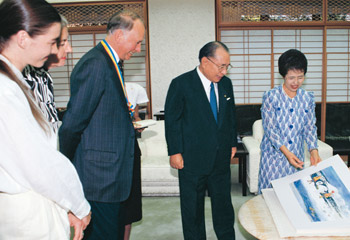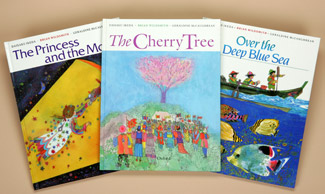Brian Wildsmith--Opening the Door to a World of Dreams, Hope and Magic
[From an essay series by Daisaku Ikeda in which he reflects on his encounters with various world figures.]
"Happiness. Children always want to be surrounded by love and security."

The Ikedas welcome the Wildsmiths and their daughter Anna (Tokyo, 1991)
I had asked Brian Wildsmith, renowned British illustrator of children's books, what he thought children really seek. "Of course, the content of that happiness changes as they grow older," he continued. "But there is one source of happiness that never changes, regardless of age. And that is creativity."
His own illustrations have been likened to "sunlight streaming from the page." Each is a breathtaking symphony of color, its composition sophisticated and intricate. Whenever I see his work, I feel anew the truth of the words "Art is born of love."
All Wildsmith's illustrations have a warmth, a pulsing life. All living things--trees and flowers, people, birds and animals--glow with the joy of life. His skies, seas, houses and landscapes are all bathed in a gentle, nostalgic light, whose source is the love and affection in his heart.
On meeting him for the first time, I was struck by his pure nature and his earnest concern for children. Wildsmith points out that in a society overflowing with material goods and information, children become accustomed to getting what they want, when they want it. The joy of discovery is lost, as well as their ability to be creative. By using the power of art, Wildsmith has devoted his life to helping children realize their hidden potential.
He has been credited with causing a revolution in illustrated books for children. When his work first appeared, many wondered whether such sophisticated and artistic illustrations would appeal to young children. But there was no need for concern: they were delighted. They enjoyed looking at the pictures and at the same time were greatly moved by their beauty.
True excellence is powerful: it alone can nourish excellence in others. Wildsmith is committed to creating pictures that encourage children to appreciate the world's beauty.
When he visited Japan in 1989, an elementary school girl told him how much she liked his illustrations, saying, "The fish are so pretty, much nicer than the ones in the encyclopedia." Wildsmith thanked his young admirer, explaining: "I use whatever colors I feel like. When I paint a fish, I paint the kind of fish I would like to see. The same is true of my trees. I don't care if they're not the colors in photographs. I paint what I see with my eyes and feel in my heart. Perhaps that is what struck you as 'pretty.' I am very glad."
There is a story that someone looking at a painting by the renowned British artist J. M. W. Turner once told him that the sunset in his painting could never exist in reality. Turner's reply was, "But don't you wish it did?" Unless we view things with our hearts, we can see nothing. But if we look at the world with a love of life, it will reveal its beauty to us.
Everything in Wildsmith's illustrations sings with life, seeming to cry out: "I am a beautiful living thing. Your life is precious, too." Every time I see his pictures, I am reminded that even the smallest detail of our existence is miraculous. When we are aware that each moment of the day, our every gesture and step, everything we speak or hear, is truly mystical and full of wonder, we can live our lives with greater thought and care. We will also have greater respect and appreciation for the lives of others.

Three children's books by Daisaku Ikeda illustrated by Brian Wildsmith
In the children's books I have written, such as The Cherry Tree and The Snow Country Prince, I have also tried to communicate the great love that fills the universe. I am so happy that Wildsmith responded to my stories and contributed his outstanding illustrations to them.
Speaking of great love, I am reminded of the strength of Wildsmith's wife, Aurelie, who has been an immense source of support to him over the years. When they were first married, Wildsmith worked as an art teacher by day and designed book jackets by night, often going without sleep. Aurelie suggested that he give up his day job and concentrate on what he really wanted to do. Although he was worried about whether he could provide for them as an illustrator, with his wife's support, he eventually decided to follow his heart. Only after he had quit his teaching job did she tell him she was carrying their first child. He writes in his autobiography, "Aurelie is a selfless person; she knew that if I had learned of her pregnancy while still employed as an art teacher, I would have continued teaching for far longer than I could bear, out of fear of financial insecurity. As it stood she did everything imaginable to bring me happiness and I believe she still does."
The story of their first meeting has the sweetness of a fairy tale. Wildsmith, 17 at the time, had gone to sketch some ancient statues at a magnificent old house built on a lake. Suddenly a young girl with a freckled face was peering earnestly over his shoulder to see what he had drawn. The 14-year-old Aurelie flipped through his sketchbook with a smile of approval. A love to last forever was born at that moment.
One of the children's books that Wildsmith has both written and illustrated is called Carousel. It is the story of a girl called Rosie, who loves to ride the merry-go-round at the annual fair. But one winter, Rosie falls ill. The doctor says that it is important for her to have hope if she is to recover. Her brother, Tom, consults with all her friends, and together they decide to draw some pictures to encourage her.
Rosie receives all kinds of pictures: a king's throne, a kangaroo, a unicorn. Each picture is of one of the figures on Rosie's beloved carousel. Tom, meanwhile, gives her a musical box in the shape of a carousel. A sudden yearning for her favorite ride wells up inside her. That night Rosie dreams that she is riding her merry-go-round through the starry sky, and the wings of hope are born in the little girl's heart. This is the kind of message Wildsmith's books illustrate.
Life tries to sustain life. I recall a story that Wildsmith once told about his family dog, Vanic. When Vanic developed brain cancer, a neighboring dog by the name of Sheriff would come to visit each morning, howling until he was allowed in to see his ailing friend. Once inside, Sheriff would sit next to Vanic and lick him from head to toe, trying to cure him. Sheriff refused to leave Vanic's side until nightfall, and he continued this devotion until Vanic finally died.
Wildsmith continues to send pictures to his friends, the children of the world, who are in need of hope and dreams. Concerned about the decline in educational standards, he agreed heartily when I told him of my desire to plant "good seeds" in children's hearts. "We must cover the world with a forest of fine human beings raised from such seeds," he said. "If we patiently tend those trees, nurture and protect them, we can undoubtedly create a paradise on earth."
To commemorate our first meeting, Wildsmith presented me with a lovely drawing. In its center is a big elephant. Sitting on the elephant's back is a lion, and on the lion a leopard, on the leopard a bear, and on the bear a little girl reaching for a star. He inscribed it, "Hoping that together we will inspire children to reach to the skies and find their own star in life." This is the conviction that guides all Wildsmith's efforts.
[Courtesy, July 2000 SGI Quarterly]












